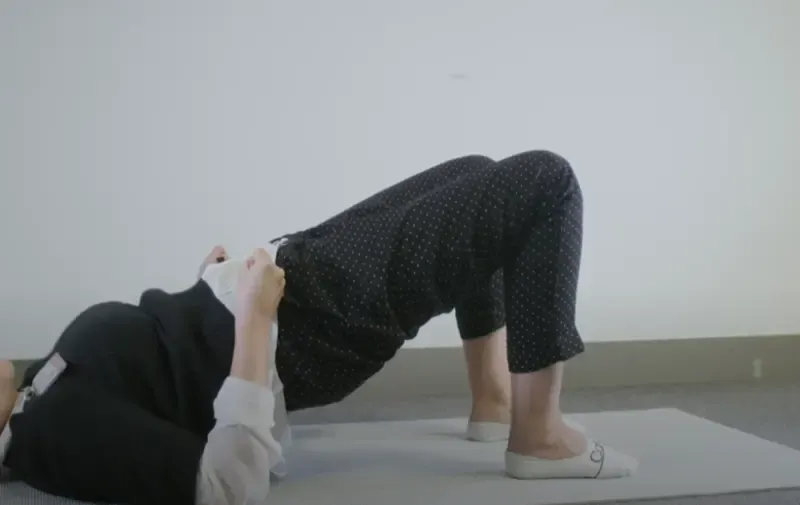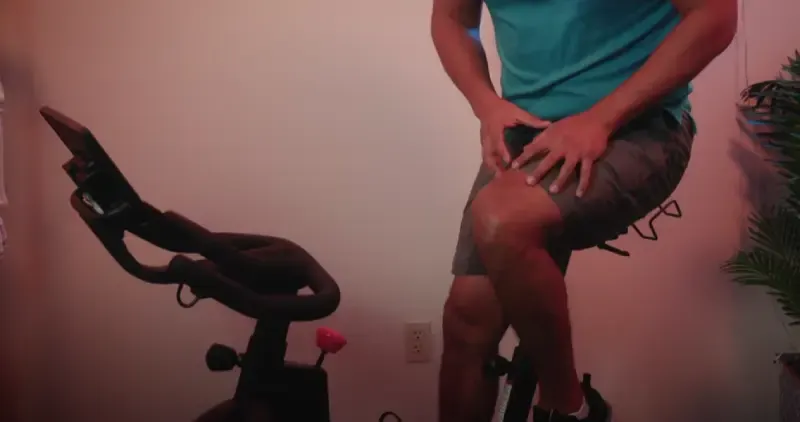Urinary tract infections can eventually cause kidney infections, kidney disease, and permanent kidney damage. It can also be accompanied by burning sensations during urination, frequent urination, cloudy urine, fever, nausea, fatigue, abdominal pain, back pain, or side pain.
Yes, leg pain can sometimes be associated with urinary tract infections (UTIs), especially during physical activities like cycling. The repetitive motion and pressure on the pelvic region may exacerbate discomfort.
In this blog post, we’ll pedal through the connection between UTIs and leg pain, explore why your cycling sessions might exacerbate the situation, and shed some light on the potential symptoms and treatment options.
Can Urinary Tract Infection Cause Leg Pain? 7 Cycling Facts
Several factors come into play to understand why leg pain may trigger urinary tract infections (UTIs) during cycling. Let’s delve into the potential causes of this discomfort:
Repetitive Motion
Cycling’s constant and repetitive motion can exacerbate UTI-related leg pain. The strain on the muscles and nerves with each pedal stroke may intensify any discomfort caused by the urine infection.
Pressure on the Pelvic Region
During cycling, the pressure exerted on the pelvic region can worsen leg pain associated with UTIs. This added pressure can further irritate inflamed tissues, potentially amplifying the pain sensation.
Nerve Irritation
Nerve irritation stemming from UTIs can contribute significantly to leg pain, especially when engaging in activities like cycling. The compromised nerve function due to infection can heighten sensitivity to pain signals.
Muscle Tension

Muscle tension resulting from UTIs can manifest as leg pain during cycling. Infections can cause muscles to contract involuntarily, leading to stiffness and discomfort that may be exacerbated by physical activity.
Reduced Blood Flow
UTIs can affect blood flow to the pelvic area, reducing leg circulation. This diminished blood flow can lead to muscle fatigue and discomfort, particularly noticeable during cycling when increased blood flow is crucial for optimal performance.
Systemic Effects
The symptoms of UTIs, like fatigue and fever, can indirectly cause leg pain while cycling. These symptoms can impact overall energy levels and muscle function, making cycling more challenging and uncomfortable.
Complications
Complications from UTIs can lead to leg pain when cycling. In severe cases, untreated UTIs can spread to other body parts, potentially affecting muscles, nerves, and overall physical well-being, resulting in increased discomfort while cycling.
Urinary Tract Infection that Can Cause Leg Pain While Cycling: 13 Symptoms
For some cyclists, the experience may be marred by unexpected leg pain. Cycling and UTIs have some interesting connections. Symptoms of urinary tract infections and leg pain while cycling:
Leg Pain
One of the most puzzling aspects of leg pain during cycling is its association with UTIs. UTIs are commonly known for causing discomfort in the urinary system, but bladder infections do not directly hurt your leg. Sometimes you feel an ache.. However, cyclists experiencing leg pain, especially with other UTI symptoms, should not dismiss the possibility of a UTI-related issue.
Flank, Abdominal, Pelvic, or Lower Back Pain
UTIs can manifest in various ways, and pain in the flank, abdomen, pelvic region, or lower back is often reported. While cycling, repetitive motion and posture can exacerbate this pain, causing discomfort that may radiate to the legs. Therefore, cyclists experiencing such pain should consider the possibility of a UTI.
Pressure in the Lower Pelvic Region
The pressure exerted on the lower pelvic region during cycling can worsen the discomfort caused by UTIs. This pressure may contribute to feelings of heaviness or pain in the pelvic area, which could extend to the legs, particularly during longer rides or on rough terrain.
Cloudy, Foul-Smelling Urine
Cloudy or foul-smelling urine is a standard indicator of a UTI. Although this symptom might not directly cause leg pain, it serves as a significant warning sign that something may be amiss in the urinary system. Ignoring such signs could worsen symptoms, including leg pain during cycling.
Urinary Incontinence
The involuntary urine leakage can be exacerbated by the physical strain of cycling, especially in individuals with UTIs. This discomfort can extend beyond the urinary system, potentially contributing to leg pain during rides.
Frequent Urination
The urge to urinate frequently is a hallmark symptom of UTIs. During cycling, this urge may become more pronounced because of pressure in the bladder and pelvic area. Cyclists experiencing frequent urination during rides should consider the possibility of an underlying UTI.
Urge Incontinence
Cycling can exacerbate urge incontinence, where individuals experience sudden, intense urges to urinate. Along with leg pain, this symptom could indicate a UTI-related issue that warrants attention.
Painful Urination (Dysuria)
Dysuria, or pain when urinating, is another common symptom of UTIs. The physical exertion and pressure on the pelvic area during cycling can worsen this discomfort, potentially leading to leg pain.
Blood in Urine (Hematuria)
Cycling can worsen hematuria, mainly if there’s an underlying UTI. While this symptom may not cause leg pain directly, it signals a potentially serious issue that requires medical attention.
Penile Pain
For male cyclists, penile pain may occur alongside other UTI symptoms. While less common than other symptoms, penile pain should not be ignored, as it could indicate a UTI or other urinary system issue.
Fatigue
Systemic effects of UTIs, such as fatigue, can contribute to leg pain. Cyclists experiencing unexplained fatigue, particularly with other UTI symptoms, should consider consulting a healthcare professional.
Fever and Chills
An infection can cause fever and chills, so they should not be taken lightly. In cycling-related leg pain, these symptoms may show a severe UTI or potential complications that require prompt medical attention.
Nausea, Vomiting, and Mental Changes
In severe cases, UTIs can lead to nausea, vomiting, and mental changes or confusion. While less common, these symptoms are concerning and should prompt immediate medical evaluation, especially if accompanied by leg pain during cycling.
UTIs and Leg Pain During Cycling: Treatment Options

When faced with the discomfort of urinary tract infections ( or UTIs) while cycling, exploring effective treatment options that address the disease and the associated symptoms is crucial. Here are some strategies to consider:
Pelvic Floor Exercises
Pelvic floor exercises, like Kegel exercises, strengthen the pelvic muscles and improve bladder control. These exercises may ease symptoms of urinary incontinence associated with UTIs.
Antibiotic Therapy
The primary treatment for UTIs involves a course of antibiotics prescribed by a healthcare provider. These medications target the underlying bacterial infection, helping to ease symptoms and promote recovery. It’s essential to complete the entire course of antibiotics as directed.
Pain Management
Take ibuprofen or acetaminophen to address leg pain during cycling to ease discomfort. Cold or heat packs may relieve muscle soreness.
Hydration
Hydration is vital for flushing out bacteria and promoting healing. Water helps reduce the concentration of urine and ease symptoms of UTIs.
Rest and Recovery
A sufficient amount of rest is necessary for the body to recover from the UTI and any associated leg pain. Avoiding strenuous activities, including intense cycling sessions, can prevent the worsening of symptoms and support healing.
Warm Baths
Taking warm baths can provide relaxation and relief from muscle tension and discomfort in the pelvic and leg areas. Adding Epsom salts to the bathwater may further enhance muscle relaxation.
Tips for Preventing UTIs and Reducing Leg Pain During Cycling
Preventing urinary tract infections (UTIs) and minimizing leg pain during cycling requires a combination of proactive measures and lifestyle adjustments. Here are some ways to prevent UTIs from bike riding and valuable tips to help you maintain urinary health and enhance your cycling experience:
- Stay Hydrated: Stay hydrated to encourage frequent urination and help flush bacteria.
- Practice Good Hygiene: Maintain proper hygiene practices, including regular showering, wearing clean and breathable clothing, and wiping out after you use the restroom.
- Urinate After Cycling: Make it a habit to urinate shortly after cycling to help eliminate bacteria that enter the urinary tract during physical activity.
- Wear Comfortable Clothing: Opt for moisture-wicking and breathable clothing during cycling to reduce friction and minimize the risk of skin irritation in the pelvic region.
- Proper Bike Fit: Ensure your bike is fitted properly to your body to prevent unnecessary strain on muscles and nerves, which can hurt your legs.
- Warm-Up and Cool Down: Incorporate stretching exercises before and after cycling to prepare your muscles for activity and prevent stiffness or cramping that may lead to leg pain.
- Pelvic Floor Exercises: Engage in pelvic floor strengthening exercises, such as Kegel, to improve muscle tone and support bladder control, reducing the likelihood of urinary incontinence during cycling.
- Balanced Diet: Maintain a healthy diet with fruits, veggies, lean proteins, and whole grains to boost immunity and reduce UTI risk.
- Listen to Your Body: Pay attention to any signs of discomfort, pain, or unusual symptoms during cycling. Take time to rest if symptoms persist or worsen.
Additional Prevention Tips For Urinary Tract Infection

Frequent urges, numbness, and tingling could signal urinary tract problems, such as infections or abnormalities. Infections of the urinary tract can be prevented by following these tips.
Change Your Peeing Habits
Simple changes in your peeing habits can help prevent UTIs. Urinate wholly and regularly, especially after activities like cycling. When urine is held in for a long time, bacteria can grow in the urinary tract, causing infections.
Wiping from front to back after using the toilet can prevent the transmission of bacteria from the anal region to the urethra, thereby lowering the likelihood of UTIs.
Change Your Birth Control
Certain types of birth control, like diaphragms and spermicides, may heighten UTI risk for some. If you face frequent UTIs with these methods, ponder shifting to other contraceptives like pills, patches, or hormonal implants.
Consulting with your healthcare provider can help you find a birth control method that suits your needs and minimizes the risk of UTIs.
Use a Water-Based Lubricant During Sex
Friction during sexual activity can irritate the urethra and increase the risk of UTIs. Lubrication with water can reduce friction and discomfort, making sex more comfortable and potentially lowering the risk of UTIs.
Avoid using products that contain irritants or allergens, as they can further irritate the genital area and increase susceptibility to infections. Communication with your partner about using lubricants can enhance sexual experiences and promote overall urinary tract health.
Change Your Clothing
Wearing tight or non-breathable clothing, especially in the genital area, can trap moisture and heat, creating an ideal environment for bacterial growth and UTI development. Opt for loose-fitting, breathable fabrics like cotton that allow air circulation and keep the genital area dry and comfortable.
Changing out of sweaty workout clothes promptly after cycling can also help prevent bacterial growth and reduce the risk of UTIs.
Conclusion
In conclusion, the link between leg pain and UTIs is not as far-fetched as it may initially appear. UTIs, while primarily affecting the urinary system, can have far-reaching effects and increase discomfort during physical activities like cycling. The good news is there’s a roadmap to relief.
Recognizing the signs and promptly seeking the proper medical attention can put the brakes on this discomfort and get you back to enjoying your cycling adventures. Remember to balance your passion for cycling with the need to listen to your body, and you’ll continue to enjoy the ride. So, keep those wheels turning, stay hydrated, and happy cycling.
FAQs
How Do You Get An Urinary Tract Infection?
Bacteria cause infections in the urinary tract. They usually enter through the urethra and infect the bladder. The bladder can also become infected through the ureters, which can eventually lead to kidney infection.
Should I Avoid Exercise With A UTI?
A UTI won’t affect your actual balance; an ear infection might! My point is to find a balance in how much exercise you do. Exercise won’t make cystitis worse. You can do gentle exercise if you feel good.


